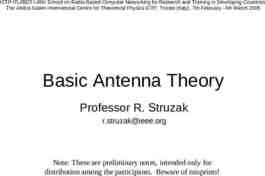A fundamental problem in Science is determining whether the
10 Slides1.46 MB
A fundamental problem in Science is determining whether the experiment data fits the results expected. How can you tell if an observed set of offspring count is legitimately the result of a given underlying simple ratio? For example: in genetics we do a cross and see: 290 purple flowers 110 white flowers in the offspring This is pretty close to a 3/4 : 1/4 ratio, but how do we formally define "pretty close"? What about 250:150?
The chi-square test is a “goodness of fit” test. It answers the question of how well do experimental data fit expectations. We start with a theory for how the offspring will be distributed: the “null hypothesis”. Example: What about the offspring of a selfpollination of a heterozygote: The null hypothesis is that the offspring will appear in a ratio of 3/4 dominant to 1/4 recessive.
Determine the number of each phenotype that have been observed and how many would be expected. “χ” is the Greek letter chi 2 “ ” is a sigma; it means to sum the following terms for all phenotypes. “obs” is the number of phenotype observed “exp” is the number of that phenotype expected from the null hypothesis. (obs exp) exp 2
We count F2 offspring, and get 290 purple and 110 white flowers. This is a total of 400 (290 110) offspring. We expect a 3/4 : 1/4 ratio. Thus we expect 400 * 3/4 300 purple, and 400 * 1/4 100 white.
Now it's just a matter of plugging into the formula: (obs exp) 2 2 2 exp (290 - 300)2 / 300 (110 - 100)2 / 100 (-10)2 / 300 (10)2 / 100 100 / 300 100 / 100 0.333 1.000 2 1.333 This is our chi-square value: now we need to see what it means and how to use it.
What is a “reasonable” result? For most uses a result is said to not differ significantly from expectations if it could happen at least 1 time in 20. “1 time in 20” can be written as a probability value p 0.05, because 1/20 0.05. Another way is: If your experimental results are worse than 95% of all similar results, they get rejected because you may have used an incorrect null hypothesis. On the exam the question will tell you the p value to use
A critical factor in using the chi-square test is the “degrees of freedom”, which is essentially the number of independent random variables involved. Degrees of freedom is simply the number of classes of offspring minus 1. For our example, there are 2 classes of offspring: purple and white. Thus, degrees of freedom (d.f.) 2 -1 1. A die has how many degrees of freedom?
Critical values for chi-square are found on tables, sorted by degrees of freedom and probability levels. Be sure to use p 0.05. If your calculated chi-square value is greater than the critical value from the table, you “reject the null hypothesis”. The data is not valid, something else affected it! If your chi-square value is less than the critical value, you “fail to reject” the null hypothesis (that is, you accept that your genetic theory about the expected ratio is correct). The data is reasonable!
Chi-Square Table
In our example of 290 purple to 110 white, we calculated a chi-square value of 1.333, with 1 degree of freedom. Looking at the table, 1 d.f. is the first row, and p 0.05 is the sixth column. Here we find the critical chi-square value, 3.841. Since our calculated chi-square, 1.333, is less than the critical value, 3.841, we “fail to reject” the null hypothesis. Thus, an observed ratio of 290 purple to 110 white is a good fit to a 3/4 to 1/4 ratio.















